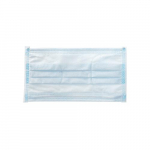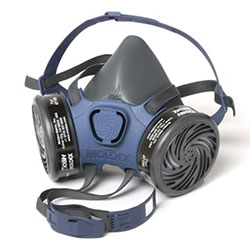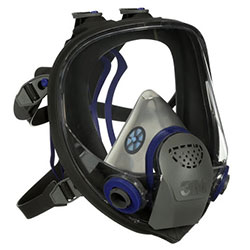
- Show results for
- Share
Mask, Respirator, Face Shield - What to Choose?
Resource Description

Doing risky work, you are required to observe regulations for ensuring safety and protection of health. Here is where Personal Protective Equipment comes in handy.
PPE is all clothing and equipment designed to protect you against hazards or minimize their impact.
Face shields, masks, and respirators are considered to protect the wearer’s face and respiratory system. But what is the difference between them? Can they be interchangeable? You may find answers to these and other questions below.
But first of all, let’s find out what people mean when speaking about respirators, facemasks, and face shields.
- What is a mask?
- What is a respirator?
- What is a face shield?
- Difference between face shields, masks, and respirators
- How to choose
What is a mask? |
A mask is a covering you put on your face for protection. It is the most common type of PPE used to prevent the spread of respiratory viruses or bacteria. Protecting from large particles in the air, it can be also used at factories.
Popular Products
What is a respirator? |
A respirator is a mask or a device that is used to protect the respiratory system. Worn on a face over the mouth and nose, it filters out dangerous substances (Air-Purifying) or provides pure air from a stationary source (Supplied-Air).
Air-Purifying Respirators are more common on the market. They are divided into two main groups: disposable and reusable.
Disposable particulate respirators
Remove very small (0.3 microns) particles (e.g. dust, viruses, bacteria) from the air you inhale. According to the performance, they are divided into three groups: 95, 99, and 100. Each type is able to filter out approximately this percentage of airborne particles. They are also rated as N (Not resistant to oil), R (resistant to oil), and P (oil proof). It’s quite essential for industries that work with oil. An N-95 respirator (alias dust mask) is the most appropriate variant for most factory workers as it’s safe and relatively easy to breathe through it.
A disposable particulate respirator is a reliable solution unless you use it wrong.
Thus, you need to know how to wear a respirator correctly:
- Cup a respirator in your hand, holding the metal nose piece in your fingertips.
Allow the straps to hang down freely.
- Position the respirator on your face so that the nose piece meets the bridge of your nose and the bottom covers your chin.
- Stretch and place the straps above and below your ears.
- Pinch the nose piece to create a seal. Make sure that it fits snugly on the bridge of your nose without gaps.
- Perform a leak test. Place your hand on the outside of the respirator. Inhale and exhale forcefully. If you notice air leaks from the edges, reposition the respirator and repeat the test until it fits properly.
Don’t forget to change your respirator at least once in 8 hours, or more often if it’s dirty, wet, or damaged. As it’s a disposable solution, don’t use it twice. Just toss it into the trash and take a new one.
Popular Products
Reusable respirators |
In contrast to disposable PPE, reusable respirators can be used many times. The only requirement is to change filters and cartridges on time. The more polluted the air is, the sooner you should replace them. Besides particulate hazards, reusable respirators are able to filter out harmful vapors or gases.
Depending on the area reusable respirators are aimed to insulate, they are divided into two groups: half- and full-face. Half-face solutions cover the nose and mouth area, while their full-face counterparts shelter the entire face, protecting the eyes as well.
 |
 |
When wearing a reusable respirator, make sure that it fits properly and there are no air leaks from edges.
Popular Products
What is a face shield? |
A face shield is a kind of PPE used to protect the entire face from flying objects, infectious materials, or chemical splashes. It is usually used in the healthcare, military, and other industries, where workers’ faces should be protected from dangerous fluids and hazards.
Face shields can be made of PolyCarbonate or Cellulose Acetate. PC is considered to be better in providing optical quality, heat, and impact resistance, while AC has a higher chemical resistance.
Popular Products
Difference between face shields, masks, and respirators
Face shields, masks, and respirators differ in levels of protection and are used to deal with different dangers.
Mask vs Respirator
Both N95 respirators and medical face masks protect the respiratory system. The main difference is that respirators preclude the wearer from inhaling small particles, whereas surgical masks prevent the spreading of large sprays and droplets.
You can find more information in a comparison table below:
| Surgical Mask | N95 Respirator | |
| Fit | loosely | tightly |
| The air filtered | exiting and partly entering | both exiting and entering |
| Protection from | large particles | small particles |
| Time of use | 2-3 hours | 8-10 hours |
Remember, both solutions should be immediately removed if they’re polluted, wet, or damaged.
To sum up, masks and respirators are for different purposes. To eliminate health
threats, you should always be aware of the danger you deal with and how to get reliable protection from
it.
Face shield vs Respirator/Mask
The same situation is with face shields. In contrast to face masks and respirators, they are not designed to protect the respiratory system at all. A face shield prevents your eyes and face from the physical damage only. Thus, while doing dangerous work, consider wearing it together with a mask or respirator, depending on the protection level you need.
Full face respirators vs face shields
A face shield with a respirator can be a good substitution of a full-face respirator.
Sometimes, these solutions can be interchangeable, but the latter provides a higher level of protection as there are
no air leaks from edges.
A face shield can prevent injuries caused by flying objects, dust, or dangerous liquids, but it is useless while dealing with harmful gases or vapors. Thus, choosing between a full-face respirator and a face shield, you should consider the danger you deal with.
How to choose
Facemasks, respirators, and face shields can protect you from hazards, but only if they are of good quality. There are some organizations that monitor the quality of PPE solutions. Thus, all good-quality respirators are approved by NIOSH and marked with this word. While choosing a surgical mask, look for a CE mark on it. And don’t forget that all face shield components should be marked with Z87 or Z87+, depending on a resisting impact they are capable of. It’s better to buy protective equipment from reliable manufacturers and distributors only. This way you can be sure that you are truly safe.


















 Accessories and expendables are for demonstration purposes only and may not supply with the product
Accessories and expendables are for demonstration purposes only and may not supply with the product 

